August 2020 LIP of the Month
The Central Atlantic Magmatic Province (CAMP) and the end-Triassic crisis
Thea Hatlen Heimdal1; Morgan Thomas Jones1; Henrik Hovland Svensen1; Sara Callegaro1
1Centre for Earth Evolution and Dynamics (CEED), University of Oslo, PO Box 1028, Blindern, NO-0315 Oslo, Norway; email: t.h.heimdal@geo.uio.no
Figures, text and tables compiled from:
Heimdal, T.H., Svensen, H.H., Ramezani, J., Iyer, K., Pereira, E., Rodrigues, R., Jones, M. T., & Callegaro, S. Large-scale sill emplacement in Brazil as a trigger for the end-Triassic crisis. Scientific Reports, 8, 141 (2018).
Heimdal, T.H., Callegaro, S, Svensen, H.H., Jones, M. T., Pereira, E., & Planke, S. Evidence for magma-evaporite interactions during the emplacement of the Central Atlantic Magmatic Province (CAMP) in Brazil. Earth and Planetary Science Letters, 506, 476-492 (2019).
Heimdal, T. H., Jones, M. T, & Svensen, H. H. Thermogenic carbon release from the Central Atlantic magmatic province caused major end-Triassic carbon cycle perturbations. Proceedings of the National Academy of Sciences of the United States of America, 117, 22 (2020).
Introduction
The Earth’s climate has remained relatively stable over the course of the last 4 billion years, allowing life to continue and evolve. However, occasionally the climate deviates from its normal stable state. In extremely rare cases, global warming of several degrees (°C) can occur in just a few thousand years, which is extremely fast in an Earth history perspective. Such rapid climate change events often coincide with the formation of Large Igneous Provinces (LIPs). A temporal link between LIPs and biotic upheavals is also well documented throughout Earth history, including four of the ‘big five’ global mass extinction events of the Phanerozoic (Wignall, 2001; Bond & Wignall, 2014; Ernst and Youbi, 2017).
The end-Triassic extinction (ETE) represents one of these ‘big five’ events. During the ETE both marine and terrestrial ecosystems were severely affected, and it has been estimated a total species loss of as much as 80 % (Beerling & Berner, 2002). The ETE is associated with global warming of up to 3-4 °C (McElwain et al., 1999) and major carbon cycle disturbances. The evidence for carbon cycle changes includes: 1) increases in the atmospheric concentration of CO2 (pCO2; McElwain et al., 1999; Schaller et al., 2011, 2012), indicating a large increase in the volume of carbon released to the atmosphere; and 2) several negative carbon isotope excursions (CIEs; e.g. Lindström et al., 2017; Korte et al., 2019), suggesting that the carbon source(s) were 12C-enriched. As the ETE is temporally linked to the Central Atlantic Magmatic Province (CAMP), it has been hypothesized that CAMP-derived emissions were responsible for the biotic crisis and contributed to the carbon cycle perturbations (e.g. Marzoli et al., 1999; Deenen et al., 2010; Schoene et al., 2010; Ruhl et al., 2011; Blackburn et al., 2013; Dal Corso et al., 2014; Davies et al., 2017; Lindström et al., 2017).
A large portion of the CAMP is preserved as sills, which are particularly widespread in the Amazonas and Solimões basins in northern Brazil (Fig. 1a; Almeida, 1986; Milani & Zalán, 1999; Gonzaga et al., 2000; Wanderley Filho et al., 2006; Barata & Caputo, 2007; Cunha et al., 2007). These sills are are estimated to represent ~ 75 % of the total volume of known CAMP sills (Svensen et al., 2018), and high precision U-Pb dating demonstrates that they were emplaced synchronously with the ETE (Davies et al., 2017; Heimdal et al., 2018). The Amazonas and Solimões basins comprise a thick sedimentary sequence, including organic-rich shales, carbonates, evaporites and hydrocarbons (Fig. 1b, c; Milani & Zalán, 1999; Gonzaga et al., 2000; Wanderley Filho et al., 2006). Interactions between the sills and such volatile-rich host-rocks could have significantly increased the volatile release (e.g. CO2, CH4, SO2 and halogens) during CAMP emplacement, through contact metamorphism and/or contamination of the magma (Fig. 2; Ganino & Arndt, 2009; Svensen et al., 2009; Black et al., 2012; Pang et al., 2013). The release of such volatiles could lead to significant environmental and climatic perturbations, through temperature change, ocean anoxia, ocean acidification, acid rain, poisoning, and/or ozone depletion (Wignall, 2001; Bond & Wignall, 2014; Jones et al., 2016). Furthermore, the release of sediment-derived CO2 and CH4 generated through thermogenic processes in organic-rich strata is 12C-enriched, and could thus potentially explain the negative CIEs.
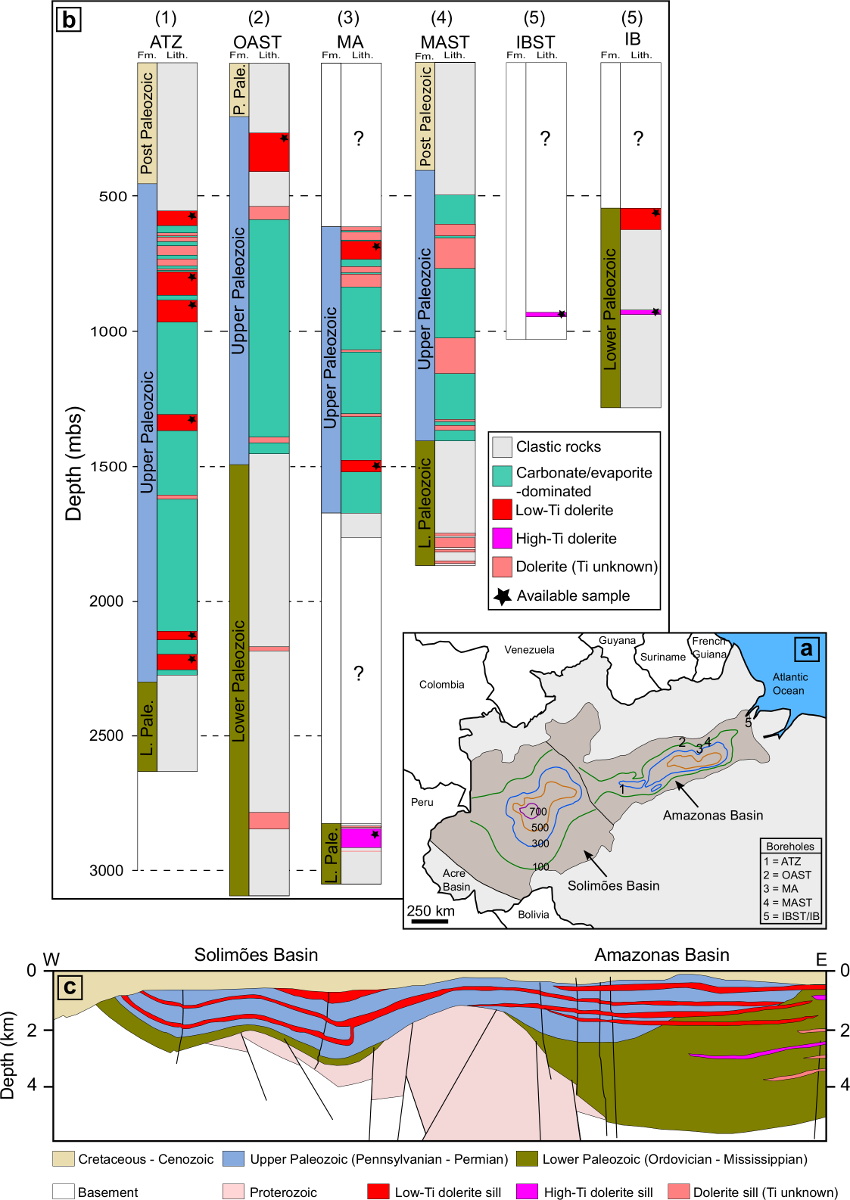
Figure 1: Location of the Amazonas and Solimões sedimentary basins in northern Brazil (a), borehole logs (b), and schematic cross-section (c). Colored contour lines represent cumulative sill thicknesses. Mbs. = meters below surface. Fm. = formation. Lith. = lithology. P. Pale. = Post Paleozoic. L. Pale. = Lower Paleozoic.
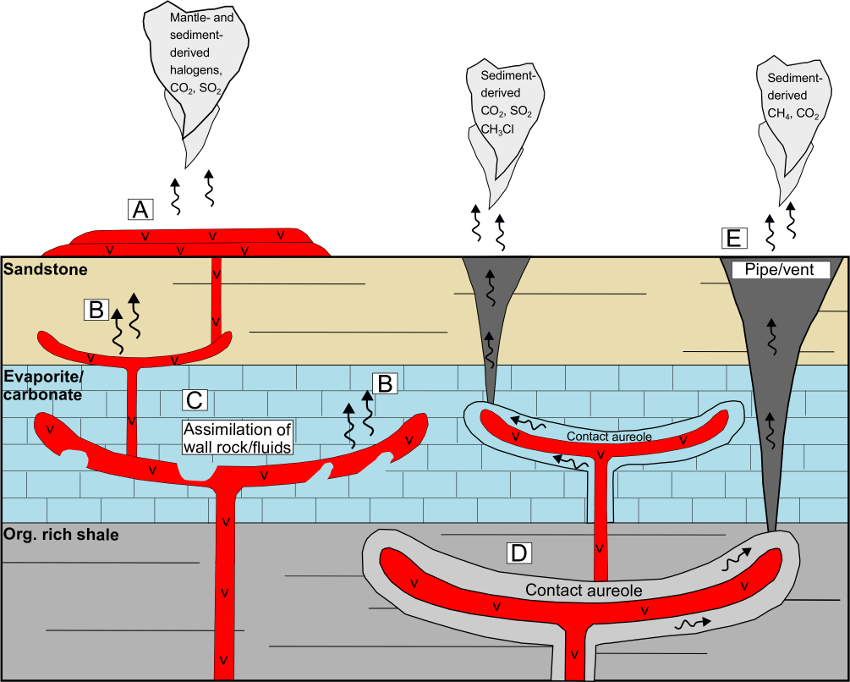
Figure 2: Schematic cross-section of a volcanic basin illustrating the potential magmatic- and metamorphic processes generating and/or releasing mantle- and sediment-derived volatiles during the emplacement of a Large Igneous Province.
Here we provide a summary of our research on the CAMP sills in the Brazilian basins, which has been published in three individual papers (Heimdal et al., 2018, 2019, 2020). This work includes geochemical/petrological/mineral chemistry/isotopic data and U-Pb geochronology from sill samples obtained from drilling in the Amazonas and Solimões basins, thermal modeling quantifying the carbon generation in the basins, and carbon cycle modeling estimating the effects of carbon release from CAMP during the end-Triassic crisis.
Overview of the sills in the Solimões and Amazonas basins
The Amazonas and Solimões sedimentary basins cover an area of more than 1 x 106 km2 (Fig 1a; Wanderley Filho et al., 2006). The sedimentary deposits are generally of Paleozoic age, and can be divided into a lower and upper unit, dominated by shales/sandstones, and carbonates/evaporites, respectively. The lower unit includes deposits of black shale with high total organic carbon (TOC) concentrations (up to 8 wt. %), while hydrocarbon reservoirs occur in both units (Milani & Zalán, 1999; Gonzaga et al., 2000; Barata & Caputo, 2007). Borehole data demonstrates that the sills represent up to 20 % of the basin stratigraphy, and individual sills can be up to 143 m thick.
More than 70 % of the sills are located within the upper Paleozoic unit, where they extend continuously from the western margin of the Solimões Basin to the eastern margin of the Amazonas Basin (Fig. 1c). These sills have TiO2 concentrations < 2.0 wt.%, and fall within the low-Ti group determined for CAMP rocks following Marzoli et al. (1999), like most intrusive/extrusive CAMP rocks in Brazil (Acre, Marañhao- Parnaíba, Anarí and Tapirapuá, Guyana cratonic block; Milani & Zalán, 1999; De Min et al., 2003; Wanderley Filho et al., 2006; Merle et al., 2011; Klein et al., 2013). The sills present in the lower Paleozoic unit are fewer in numbers, less widespread, and restricted to the eastern part of the Amazonas basin (Fig. 1c). A portion of these sills are defined as high-Ti (TiO2 > 2.0 wt.%). No high-Ti occurrences have been observed within the upper Paleozoic unit or within the Solimões Basin.
High-precision U-Pb geochronology demonstrates a total duration of CAMP activity of up to 800 kyr (Schoene et al., 2010; Blackburn et al., 2013; Davies et al., 2017; Heimdal et al., 2018), which can be divided into four main phases (Fig. 3a). The dated low-Ti sills and one high-Ti sill overlap with the ‘main’ CAMP phase, while the youngest high-Ti sill is coincident with the onset of the ‘late’ phase (Fig. 3a). Recent correlations constrain the timing between CAMP activity, pCO2 peaks and the CIEs (Lindström et al., 2017), and show that the oldest sills overlap with the earliest pCO2 peak and the Marshi CIE 1, while the youngest high-Ti sill overlaps with the second Spelae CIE 2 (Fig. 3b). Considering the composition of host-rock intruded by these sills, the earlier sill intrusions generated both organic- and inorganic-derived carbon, while the later pulse of high-Ti magmatism is likely to have volatilized predominantly organic-derived carbon.
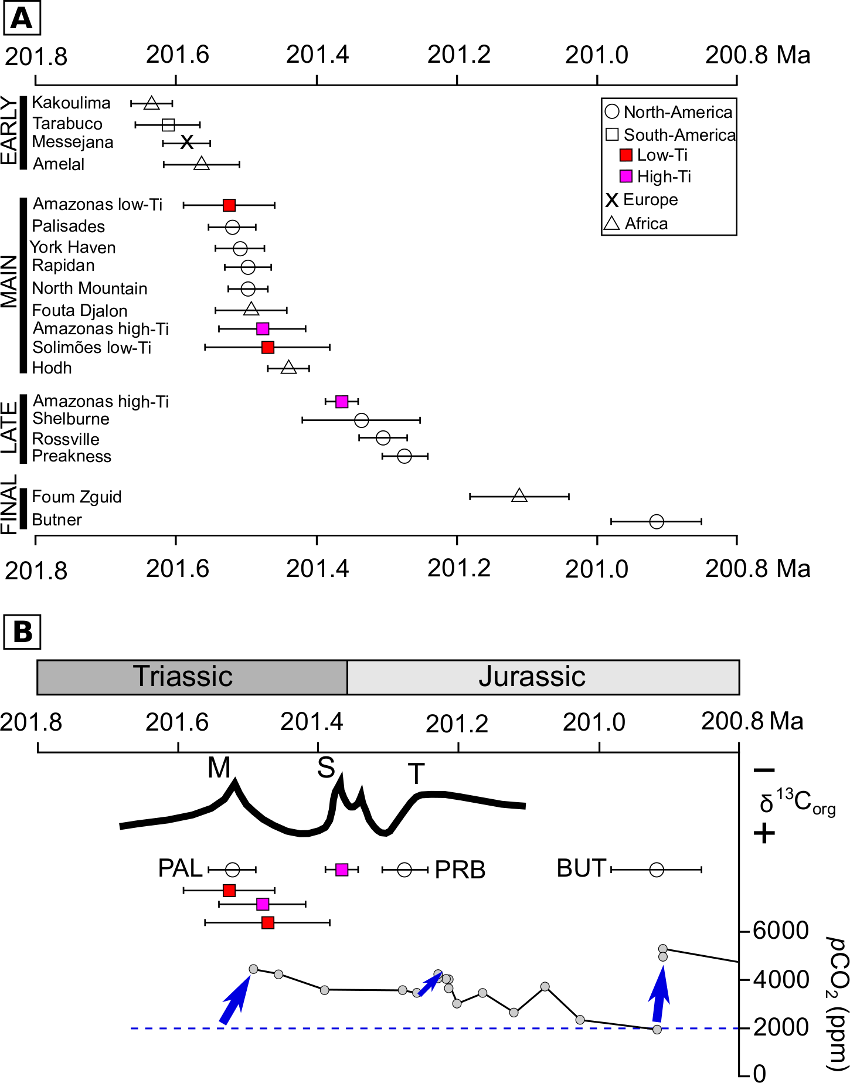
Figure 3: Compilation of available high-precision U-Pb ages of CAMP rocks (a; Schoene et al., 2010; Blackburn et al., 2013; Davies et al., 2017; Heimdal et al., 2018) and timeline of selected CAMP rocks, pCO2 data (Schaller et al., 2011) and a composite carbon isotope curve (b; after Lindström et al., 2017). PAL = Palisades Sill. PRB = Preakness Basalt. BUT = Butner diabase.
Modeling the thermogenic carbon generation and release
The magnitude of carbon generated during contact metamorphism in the Solimões and Amazonas basins was calculated using a one-dimensional (1D) numerical model, Silli 1.0 (Iyer et al., 2018). The model calculates organic carbon generated from breakdown of organic matter, and inorganic carbon generated during heating of marls/carbonates. Note that contact metamorphism of organic matter-bearing rocks will generate both CO2 and CH4; however as these ratios are poorly constrained, model results are presented as CO2 only. The model input data was based on the lithology of three boreholes from the Amazonas basin (ATZ, OAST and MAST; Fig 1b), and model results show a generation of 52 to 103 ton/m2 CO2.
A basin scale value was calculated based on carbon generation within the upper Paleozoic unit from boreholes ATZ and MAST, as these lithologies were considered to be representative for both basins. The modeled CO2 value of 97 ton/m2 was extrapolated to the total area of Paleozoic sedimentary rocks (900,000 km2; Milani & Zalán, 1999; Cunha et al., 2007), which yielded a total production of 88,000 Gt CO2. Contact metamorphism of lower Paleozoic rocks (with TOC up to 8 wt. %) likely contributed significantly to the total volatile load, however the localized nature of the sill emplacement in these rocks limits the constraints on the areal extent of affected host-rock. Furthermore, the model does not account for interactions between sills and pre-existing hydrocarbons (Iyer et al., 2018), which likely lead to enhanced volatile generation in both basins (Mello et al., 1994; Milani & Zalán, 1999; Gonzaga et al., 2000; Wanderley Filho et al., 2006). The basin scale estimate of 88,000 Gt CO2 is therefore likely a conservative estimate.
This thermogenic carbon generation estimate, together with available high-precision U-Pb ages and correlations, allows to identify detailed and realistic emission scenarios from CAMP which can be tested by carbon cycle modeling. Such tests can shed some light on whether CAMP-derived carbon emissions could have been responsible for the observed carbon cycle perturbations associated with the ETE. Previous carbon cycle models have shown that the release of mantle-derived carbon (δ13C of – 5 ‰) from CAMP cannot account for the negative CIEs (Beerling & Berner, 2002; Paris et al., 2012; Bachan & Payne, 2016), thus 12C-enriched thermogenic organic carbon represents a plausible source for the negative excursions.
Carbon emission scenarios from CAMP tested using the Long-Term Ocean-Atmosphere-Sediment Carbon Cycle Reservoir Model (LOSCAR; Zeebe et al., 2012) showed that a total release of ~ 24,000 Gt C replicates observed pCO2 and δ13C values (Fig. 4). This value includes the release of three thermogenic carbon pulses with a total magnitude of 12,100 Gt. Volatiles generated by thermogenic processes will be partly released, and partly trapped in the host sedimentary rocks. The modeling demonstrates that, in order to explain the observed carbon cycle changes, only 50 % of the generated carbon gases in the Amazonas and Solimões basins is required to be released (88,000 Gt CO2 = 24,000 Gt C). The released pulses of thermogenic carbon were given δ13C values between -41 and -20 ‰, so an extremely isotopically depleted carbon source (e.g. biogenic CH4; Milkov & Etiope, 2018) is not needed to replicate the negative CIEs.
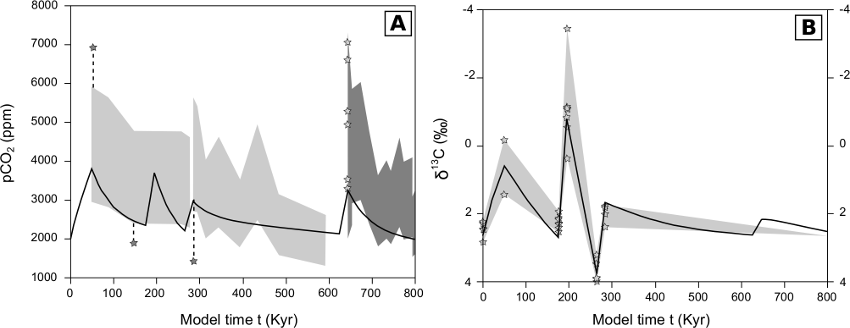
Figure 4: Model response of atmospheric pCO2 (a) and δ13C of shallow ocean sediments (b) to a CAMP emission scenario. Gray outlines/star symbols represent the range of observed δ13Ccarb values (Pálfy et al., 2001; Galli et al., 2005, 2007; McRoberts et al., 1997) and pCO2 data (light gray: Schaller et al., 2011; dark gray: Schaller et al., 2012).
Magma-evaporite interactions in the Solimões and Amazonas basins
While the release of carbon from CAMP can explain the observed carbon cycle perturbations, it cannot necessarily explain the ETE. For example, the Karoo-Ferrar and North Atlantic Igneous Province LIPs are both linked to dramatic climatic changes and negative CIEs, but only minor extinctions events (Svensen et al., 2004, 2007). It has been hypothesized that the environmental impact of a LIP depends on the composition of intruded host rock (Svensen et al., 2009; Ganino & Arndt, 2009; Aarnes et al., 2010, 2011). The CAMP and the Siberian Traps represent LIPs that are temporally linked to global mass extinction events, and both have intruded evaporite deposits (Svensen et al., 2009). Interactions between magmas and evaporites, including the incorporation of sedimentary pore fluids (e.g. brines), can significantly increase volatile contents of magmas (Michael & Schilling, 1989; Chevychelov & Suk, 2003; Ripley et al., 2003; Coombs et al., 2004; Li et al., 2009; Sobolev et al., 2009; Black et al., 2012; Iacono-Marziano et al., 2017). The release of evaporite-derived S, Cl and/or F can lead to photosynthetic shutdown, acid rain and ozone-depletion (Wignall, 2001; Bond & Wignall, 2014; Jones et al., 2016).
Magma contamination by evaporites may be reflected by high halogen (e.g. Cl, F) contents in halogen-bearing minerals, such as biotite. Abundant biotite (together with apatite, alkali-feldspar and quartz) was found in small independent pockets within the bulk framework of coarser plagioclase and clinopyroxene laths in the sills (Fig. 5). The biotite was interpreted to have an igneous origin, based on the crystal shape and the lack of overgrowths or reaction rims around primary minerals. Biotite compositions from 15 sill samples were obtained using an electron microprobe. Biotite from sills emplaced in clastic host-rocks have Cl concentrations < 0.9 wt.%, which is within the common range for biotite (< 1.0 wt.%; Léger et al., 1996). In contrast, sills emplaced in evaporite-bearing host-rock contain extremely Cl-enriched biotites (up to 4.7 wt.%). This clear correlation between the Cl concentrations in biotite and host-rock lithology (Fig. 6a), strongly suggests that the Cl is evaporite-sourced, and likely reflect halite contamination.
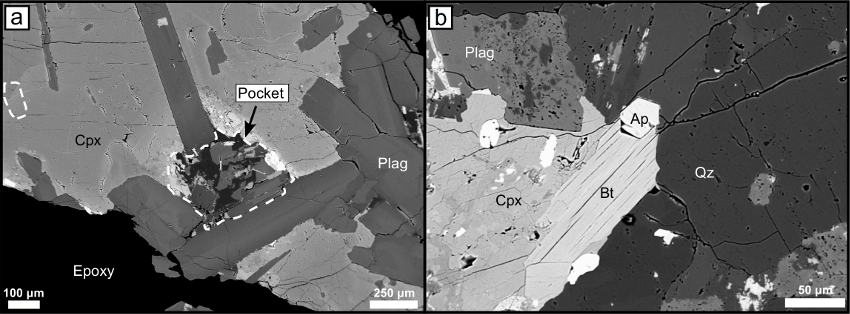
Figure 5: Backscatter electron microprobe images of a low-Ti sill from the Solimões basins show a bulk of clinopyroxene and plagioclase phenocrysts, and independent pockets of quartz, alkali-feldspar, biotite and apatite microphenocrysts (a). b: zoom-in of pocket domains. Plag = plagioclase. Cpx = clinopyroxene. Bt = biotite. Ap = apatite. Qz = quartz.
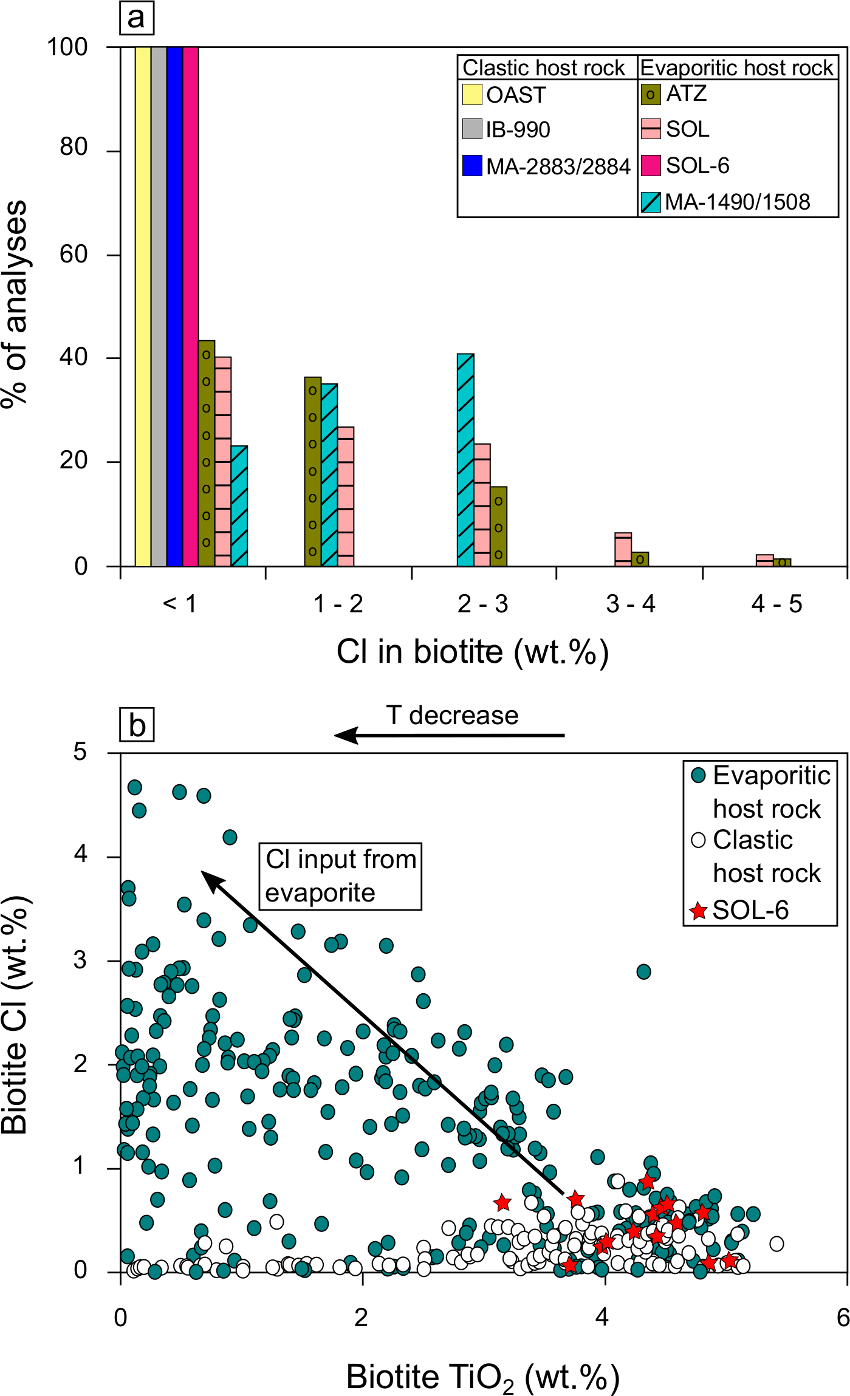
Figure 6: There is a clear correlation between host-rock lithology and Cl concentrations in biotite, with Cl concentrations < 1.0 wt.% for sills in clastic host-rock, and a wide range in Cl for sills in evaporitic host-rock (a). Biotite in sills with evaporitic host-rock show an increase in Cl with decreasing TiO2, suggesting input of Cl into the magmatic system during crystallization and cooling (b).
Plots of TiO2 versus Cl concentrations for biotite with Cl > 1.0 wt%, show that Cl generally increases with decreasing TiO2 (Fig. 6b). As the solubility of Ti in biotite generally decreases with decreasing temperature with respect to magmas (Robert, 1976), this trend was interpreted to follow an input of Cl from halite into the magmatic system during crystallization and cooling of the sills. The mechanism(s) responsible for the halite-derived Cl contamination of the magma is not clear, however possible mechanisms include include partial melting or chemical dissolution of halite, contamination by brines, or a combination of the different processes (Ripley et al., 2003; Li et al., 2009; Pang et al., 2013; Schofield et al., 2014; Iacono Marziano et al., 2017; Yudovskaya et al., 2018). More importantly, as the textural evidence suggests that the biotite is of igneous origin, the mechanism(s) likely occurred while the sills were still crystallizing, and therefore would have led to an increase of the total Cl content of the magma.
Cl-rich biotites were found in dolerites from both the Amazonas and Solimões basins (area > 1 x 106 km2; Wanderley Filho et al., 2006), which suggests that the contamination process occurred on a large scale. This large-scale halite contamination of the sub-volcanic complex potentially led to the release of significantly more Cl, as opposed to release of mantle-derived Cl only. This could have had major implications for the end-Triassic environment through atmospheric poisoning and ozone depletion (Svensen et al., 2009; Aarnes et al., 2011; Black et al., 2012).
References
Aarnes, I., Svensen, H., Connolly, J.A., & Podladchikov, Y.Y. How contact metamorphism can trigger global climate changes: Modeling gas generation around igneous sills in sedimentary basins. Geochimica et Cosmochimica Acta, 74(24), 7179-7195 (2010).
Aarnes, I., Fristad, K., Planke, S., & Svensen, H. The impact of host-rock composition on devolatilization of sedimentary rocks during contact metamorphism around mafic sheet intrusions. Geochemistry, Geophysics, Geosystems, 12(10) (2011).
Almeida, F.F.M. Distribução regional e relações tectônicas do magmatismo pós-Paleozoico no Brasil. Revista Brasileira de Geociências, 16, 325-349 (1986).
Bachan, A., & Payne, J.L. Modelling the impact of pulsed CAMP volcanism on pCO2 and δ13C across the Triassic–Jurassic transition. Geological Magazine, 153(2), 252-270 (2016).
Barata, C.B., & Caputo, M.V. Geologia do petróleo da Bacia do Solimões. O “Estado da arte” in 4 Congresso Brasileiro de Pesquisa e Desenvolvimento em Petróleo e Gás, PDPETRO, 4, 1.1 (2007).
Beerling, D.J., & Berner, R.A. Biogeochemical constraints on the Triassic-Jurassic boundary carbon cycle event. Global Biogeochemical Cycles, 16(3) (2002).
Black, B.A., Elkins-Tanton, L.T., Rowe, M.C., & Peate, I.U. Magnitude and consequences of volatile release from the Siberian Traps. Earth and Planetary Science Letters, 317, 363-373 (2012).
Blackburn, T.J. et al. Zircon U-Pb Geochronology Links the End-Triassic Extinction with the Central Atlantic Magmatic Province. Science, 340(6135), 941-945 (2013).
Bond, D. P.G., & Wignall, P.B. Large igneous provinces and mass extinctions: an update. The Geological Society of America. Special Paper 505 (2014).
Chevychelov, V, Yu., & Suk, N, I. Influence of the composition of magmatic melt on the solubility of metal chlorides at pressures of 0.1-3.0 kbar. Petrology, 11, 62-74 (2003).
Coombs, M. L., Sisson, T. W., & Kimura, J.-I. Ultra-high chlorine in submarine Kilauea glasses: evidence for direct assimilation of brine by magma. Earth and Planetary Science Letters, 217, 297-313 (2004).
Cunha, P. R. C., Melo, J. H. G, & da Silva, O. B. Bacia do Amazonas. Boletim de Geociências da PETROBRAS, 15, 227-251 (2007).
Dal Corso, J. et al. The dawn of CAMP volcanism and its bearing on the end-Triassic carbon cycle disruption. Journal of the Geological Society, 171(2), 153-164 (2014).
Davies, J. H. F. L. et al. End-Triassic mass extinction started by intrusive CAMP activity. Nature Communications, 8, 1-8 (2017).
Deenen, M. H. L. et al. A new chronology for the end-Triassic mass extinction. Earth and Planetary Science Letters, 291, 113-125 (2010).
De Min, A. et al. The Central Atlantic Magmatic Province (CAMP) in Brazil: petrology, geochemistry, 40Ar/39Ar ages, paleomagnetism and geodynamic implications in The central Atlantic magmatic province: insights from fragments of Pangea (eds. Hames, W. E.,
McHone, J. G., & Munha, J.), 91-128 (AGU Geophysical Monographs, 2003).
Ernst, R.E., & Youbi, N. How Large Igneous Provinces affect global climate, sometimes cause mass extinctions, and represent natural markers in the geological record. Palaeogeography, Palaeoclimatology, Palaeoecology, 478, 30-52 (2017).
Galli, M. T., Jadoul, F., Bernasconi, S. M., & Weissert, H. Anomalies in global carbon cycling and extinction at the Triassic/Jurassic boundary: evidence from a marine C-isotope record. Palaeogeography, Palaeoclimatology, Palaeoecology, 216, 203-214 (2005).
Galli, M. T., Jadoul, F., Bernasconi, S. M., Cirilli, S., & Weissert, H. Stratigraphy and palaeoenvironmental analysis of the Triassic-Jurassic transition in the western Southern Alps (Northern Italy). Palaeogeography, Palaeoclimatology, Palaeoecology, 244, 52-70 (2007).
Ganino, C., & Arndt, N. T. Climate changes caused by degassing of sediments during the emplacement of large igneous provinces. Geology, 37(4), 323-326 (2009).
Gonzaga, F. G., Gonçalves, F. T. T., Coutinho, L. F. C. Petroleum geology of the Amazonas Basin, Brazil: modeling of hydrocarbon generation and migration in Petroleum systems of South Atlantic margins (eds. Mello, M. R., Katz, B. J.) 159-178 (AAPG Memoir, 2000).
Iacono-Marziano, G., Ferraina, C, Gaillard, F., Di Carlo, I., & Arndt, N. T. Assimilation of sulfate and carbonaceous rocks: Experimental study, thermodynamic modeling and application to the Noril`sk-Talnakh region (Russia). Ore Geology Reviews, 90, 399-413 (2017).
Iyer, K., Svensen, H., & Schmid, D. W. SILLi 1.0: a 1-D numerical tool quantifying the thermal effects of sill intrusions. Geoscientific Model Development, 11, 43-60 (2018).
Jones, M. T., Jerram, D. A., Svensen, H. H., & Grove, C. The effects of large igneous provinces on the global carbon and sulphur cycles. Palaeogeography, Palaeoclimatology, Palaeoecology, 441, 4-21 (2016).
Klein, E. L., Angélica, R. S., Harris, C., Jourdan, F., & Babinski, M. Mafic dykes intrusive into Pre-Cambrian rocks of the São Luís cratonic fragment and Gurupi Belt (Parnaíba Province), north-northeastern Brazil: Geochemistry, Sr-Nd-Pb-O isotopes, 40Ar/39Ar geochronology, and relationships to CAMP magmatism. Lithos, 172-173, 222-242 (2013).
Korte, C., Ruhl, M., Pálfy, J., Ullmann, C. V., & Hesselbo, S. P. Chemostratigraphy across the Triassic-Jurassic Boundary in Chemostratigraphy across major chronological boundaries (eds. Sial, A. N., Gaucher, C., Ramkumar, M., & Ferreira, V. P), 240, 185-210 (Geophysical Monograph, 2019).
Léger, A., Rebbert, C., Webster, J. Cl-rich biotite and amphibole from Black Rock Forest, Cornwall, New York. American Mineralogist, 81, 495-504 (1996).
Li, C., Ripley, E. M., Naldrett, A. J., Schmitt, A. K., & Moore, C. H. Magmatic anhydrite-sulfide assemblages in the plumbing system of the Siberian Traps. Geology, 37(3), 259-262 (2009).
Lindström, S. et al. A new correlation of Triassic-Jurassic boundary successions in NW Europe, Nevada and Peru, and the Central Atlantic Magmatic Province: A time-line for the end-Triassic mass extinction. Palaeogeography, Palaeoclimatology, Palaeoecology, 478, 80-102 (2017).
Marzoli, A. et al. Extensive 200-million-year-old continental flood basalts of the Central Atlantic Magmatic Province. Science, 284(5414), 616-618 (1999).
McElwain, J. C., Beerling, D. J., & Woodward, F. I. Fossil plants and global warming at the Triassic-Jurassic boundary. Science, 285(5432), 1386-1390 (1999).
McRoberts, A. A., Furrer, H., & Jones, D. S. Palaeoenvironmental interpretation of a Triassic-Jurassic boundary section from Western Austria based on palaeoecological and geochemical data. Palaeogeography, Palaeoclimatology, Palaeoecology, 136, 79-95 (1997).
Merle, R. et al. 40 Ar/39 Ar ages and Sr–Nd–Pb–Os geochemistry of CAMP tholeiites from Western Maranhão basin (NE Brazil). Lithos, 122(3), 137-151 (2011).
Michael, P. J., & Schilling, J-G. Chlorine in mid-ocean ridge magmas: Evidence for assimilation of seawater-influences components. Geochimica et Cosmochimica Acta, 53, 3131-3143 (1989). Milani, E. J., & Zalan, P. V. An outline of the geology and petroleum systems of the Paleozoic interior basins of South America. Episodes, 22, 199-205 (1999).
Milkov, A. V., & Etiope, G. Revised genetic diagrams for natural gases based on a global dataset of >20,000 samples. Organic Geochemistry, 125, 109-120 (2018).
Pálfy, J. et al. Carbon isotope anomaly and other geochemical changes at the Triassic-Jurassic boundary from a marine section in Hungary. Geology, 29(11), 1047-1050 (2001).
Pang, K. N. et al. A petrologic, geochemical and Sr–Nd isotopic study on contact metamorphism and degassing of Devonian evaporites in the Norilsk aureoles, Siberia. Contributions to Mineralogy and Petrology, 165(4), 683-704 (2013).
Paris, G., Donnadieu, Y., Beaumont, V., Fluteau, F., & Goddéris, Y. Modeling the consequences on late Triassic environment of intense pulse-like degassing during the Central Atlantic Magmatic Province using the GEOCLIM model. Climate of the Past Discussions, 8(3), 2075-2110 (2012).
Ripley, E. M., Lightfoot, P. C., Li, C., & Elswick, E. R. Sulfur isotopic studies of continental flood basalts in the Noril’sk region: Implications for the association between lavas and ore-bearing intrusions. Geochimica et Cosmochimica Acta, 67(15), 2805-2817 (2003).
Robert, J. L. Titanium solubility in synthetic phlogopite solid solutions. Chemical Geology, 17, 213-227 (1976).
Ruhl, M., & Kürschner, W. M. Multiple phases of carbon cycle disturbance from large igneous province formation at the Triassic-Jurassic transition. Geology, 39(5), 431-434 (2011).
Schaller, M. F., Wright, J. D., & Kent, D. V. Atmospheric PCO2 Perturbations Associated with the Central Atlantic Magmatic Province. Science, 331(6023), 1404-1409 (2011).
Schaller, M. F., Wright, J. D., Kent, D. V., & Olsen, P. E. Rapid emplacement of the Central Atlantic Magmatic Province as a net sink for CO2. Earth and Planetary Science Letters, 323-324, 27-39 (2012).
Schoene, B., Guex, J., Bartolini, A., Schaltegger, U., & Blackburn, T. J. Correlating the end-Triassic mass extinction and flood basalt volcanism at the 100 ka level. Geology, 38(5), 387-390 (2010).
Schofield, N. et al. Mobilizing salt: magma-salt interactions. Geology, 42(7), 599-602 (2014).
Sobolev, A. V., Krivolutskaya, N. A., & Kuzmin, D. V. Petrology of the Parental Melts and Mantle Sources of Siberian Trap Magmatism. Petrology, 17(3), 253-286 (2009).
Svensen, H. et al. Release of methane from a volcanic basin as a mechanism for initial Eocene global warming. Nature, 429(6991), 542-545 (2004).
Svensen, H. et al. Hydrothermal venting of greenhouse gases triggering Early Jurassic global warming. Earth and Planetary Science Letters, 256(3), 554-566 (2007).
Svensen, H. et al. Siberian gas venting and the end-Permian environmental crisis. Earth and Planetary Science Letters, 277(3), 490-500 (2009).
Svensen, H.H. et al. Gondwana LIPs: Plate reconstructions, volcanic basins and sill volumes in Large Igneous Provinces from Gondwana and Adjacent Regions (eds. Sensarma, S., & Storey, B. C.), 463, 17-40 (The Geological Society of London, Special Publications, 2018).
Wanderley Filho, J. R., Travassos, W. A. S., & Alves, D. B. O diabásio nas bacias paleozoicas amazônicas-herói ou vilão. Boletim de Geociências da Petrobrás, 14(1), 177-184 (2006).
Wignall, P. B. Large igneous provinces and mass extinctions. Earth-science Reviews, 53, 1-33 (2001).
Yudovskaya, M. A., et al. Anhydrite assimilation by ultramafic melts of the Bushveld Complex, and its consequences to petrology and mineralization in Metals, minerals and society (eds. Arribas, A. M. R., & Mauk, K. L.), 21, 177-206 (Society of Economic Geologists, Special Publication, 2018).
Zeebe, R.E. LOSCAR: Long-term Ocean-atmosphere-Sediment CArbon cycle Reservoir Model v2.0.4. Geoscientific Model Development, 5, 149-166 (2012).
